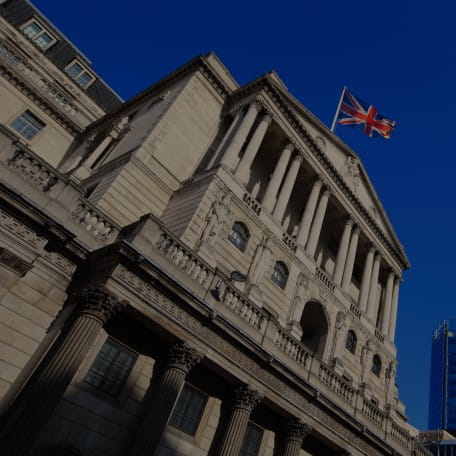- Bank of America survey shows largest bonds overweight versus equities since 2009.
- Global government bonds lost almost a fifth of value in 2022, drawing in investors.
- Bond yield curve is also ‘inverted’, drawing recession predictions and contributing to banks crisis.
- Liontrust managers comment on where they find value in global bonds.
Professional investors are favouring bonds over equities to a degree not seen since the global financial crisis, according to a key banking survey.
When we consider the repricing of the bond market over the last year or two, this probably shouldn’t be viewed as a surprising statistic.
For example, yields on 5-year US government bonds rose from around 1.25% at the start of 2022 to near 4.0% by the end.
Seemingly small yield changes (i.e. 2.75 percentage points in this example) can have a much bigger impact on the value of bonds, in a relationship known as duration – the level of sensitivity of bond prices to yield changes. The FTSE World Government Bond Index has a duration of 7.6 years, meaning it moves 7.6% for every one percentage point change in yields. In 2022, its total return was -18%, as substantial price losses more than offset income received.
This magnitude of price move is clearly likely to attract the interest of active fund managers, as it has done for Aitken Ross of the Liontrust Sustainable Investment team: “After government bonds suffered their worst returns in 20 years in 2022, we took advantage of rebased valuations to increase allocation to the asset class and raise portfolio duration.”
The shift up in bond yields in 2022 reflected a sea change in expectations for interest rate increases from central banks, as they began to rapidly raise rates in order to tackle persistent inflation. This shift was accompanied by an uplift in bond market volatility, a development which was welcomed by Donald Phillips of Liontrust’s Global Fixed Income team:
“In the second half of 2022, we increased duration above our neutral level of 4.5 for the first time since the strategic funds launched in 2018 and we have been very active in dynamically managing it around this level to capture the fluctuations in yields as ‘peak rate’ forecasts have see-sawed in both scale and timeline.”
The sentiment is echoed by John Husselbee of Liontrust’s Multi-Asset team in their new recent review of asset allocation, in which he also considers the relative value on offer in different segments of bond markets:
“We believe now is an attractive entry point for high yield and corporate bonds because of the spreads that are available versus government bonds. Global high yield spreads are now comparable to levels seen in 2016 and the Covid pandemic.
“The yields are sufficiently rewarding to compensate for potentially higher default levels. High-yield assets tend to have shorter durations than government bonds, so this will help reduce our interest rate sensitivity at the margin.
“The yields on gilts have drifted to above 3% and these could continue to rise in line with base rates. They now offer the prospect of delivering real yields over the medium term once the inflationary spike abates.”
Data from the Bank of America, which conducts a global monthly fund manager survey of around 300 participants responsible for assets of over $700bn, highlights that these managers are not alone in seeing bond market value.
The survey canvasses views on topics such as economic forecasts of growth and inflation, central bank policy expectations, asset allocation, and sector and style preferences. The standout data point from April’s report – released earlier this week – was that investors’ net allocation to bonds versus equities has hit its largest overweight position since March 2009.
The bond market’s sell off has had other consequences aside from catching the attention of asset allocators. One aspect which has been brought sharply into view recently is the shape of the yield curve.
In very simple terms, the yield curve plots the level of yield available on a bond against the length of the loan (the bond’s maturity) in years. For a variety of reasons, this curve is normally upward sloping, with higher yields offered by longer-dated bonds.
When it is inverted, short-dated bonds offer great yields than longer-dated bonds. This is often cited as a recession indicator, as one of the key determinants of yield curve shape is central bank interest rates; an inverted curve suggests interest rates are forecast to get lower, with the implication that central bank rate cuts would stem from weakening economic conditions.
Yield curves are currently inverted and have been, in the US at least, since the middle of last year. One side effect has been that bank depositors have begun to shop around, encouraged by the relatively high level of short-term interest rates available in bond markets when compared with more meagre rates on banking accounts. This risk of deposit flight was one of the key factors in the confidence mini-crisis suffered by the banking sector in March following the collapse of Silicon Valley Bank.
This crisis may have wider ramifications for the bond market beyond just the banking sector, with monetary policy acting as a feedback loop. If banks respond to balance sheet concerns by tightening lending standards, the overall supply of credit in the economy may contract. This would have a negative impact on economic activity akin to a rate increase from a central bank and therefore may reduce the need for such hikes. As we have established, changes to rate expectations can have big implications for bond yields and prices.
As Phil Milburn (Global Fixed Income team) explains “Lending standards had already been tightening significantly before Silicon Valley Bank and Signature failed. This tightening in lending standards, and fall in economic sentiment, can do some of the US Federal Reserve’s monetary tightening job for it.
In March we increased the size of our yield curve ‘steepener’, by taking net duration exposure in the 15+ year maturity bucket to zero. The lower predicted terminal Fed funds rates and weakening growth outlook have already led to some steepening (or reduced curve inversion) and we expect much more normalisation to follow.”
Ross agrees “The full effect of the significant monetary policy tightening on the economy is still to be felt and a tightening in bank lending standards will surely follow from SVBs collapse, which will add to the economic headwinds.
“Given this, we believe that the market is pricing in too many rate hikes and expect that we are close to the peak in interest rates.”
KEY RISKS
Past performance is not a guide to future performance. The value of an investment and the income generated from it can fall as well as rise and is not guaranteed. You may get back less than you originally invested.
The issue of units/shares in Liontrust Funds may be subject to an initial charge, which will have an impact on the realisable value of the investment, particularly in the short term. Investments should always be considered as long term.
DISCLAIMER
This is a marketing communication. Before making an investment, you should read the relevant Prospectus and the Key Investor Information Document (KIID), which provide full product details including investment charges and risks. These documents can be obtained, free of charge, from www.liontrust.co.uk or direct from Liontrust. Always research your own investments. If you are not a professional investor please consult a regulated financial adviser regarding the suitability of such an investment for you and your personal circumstances.
This should not be construed as advice for investment in any product or security mentioned, an offer to buy or sell units/shares of Funds mentioned, or a solicitation to purchase securities in any company or investment product. Examples of stocks are provided for general information only to demonstrate our investment philosophy. The investment being promoted is for units in a fund, not directly in the underlying assets. It contains information and analysis that is believed to be accurate at the time of publication, but is subject to change without notice. Whilst care has been taken in compiling the content of this document, no representation or warranty, express or implied, is made by Liontrust as to its accuracy or completeness, including for external sources (which may have been used) which have not been verified. It should not be copied, forwarded, reproduced, divulged or otherwise distributed in any form whether by way of fax, email, oral or otherwise, in whole or in part without the express and prior written consent of Liontrust.










